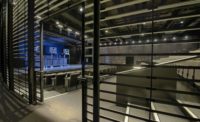There is a misconception that acoustic ceiling panels are as effective as walls at blocking sound and that where sound blocking is required, sound absorption is less important. This is not true. Sound absorption is a critical component of every room that will be occupied by people and, while modular acoustic ceilings are not effective at blocking sound—they are, in fact, very good at absorbing it. Ceilings are for absorbing noise. Walls are for blocking noise.
Myth 1: It’s OK to sacrifice ceiling absorption (NRC) for higher blocking (CAC).
Truth: Good acoustic design begins with the optimal sound absorption rating for the ceiling. This should never be compromised in hopes of also blocking noise with the ceiling.
Effective noise control should start with the optimal sound absorption ratings for the ceiling panels. They serve to absorb the noise in large open areas, preventing it from bouncing off surfaces, and spreading through spaces and down corridors causing disruptions. In fact, the maximum permissible reverberation times are decreasing in building standards and guidelines, meaning high-performing ceilings with a Noise Reduction Coefficient of NRC 0.90+ are not only recommended but in many spaces are required.
Where low-performing ceilings are installed, additional absorption on the walls and floor may be required, adding avoidable costs. Remember the Good, Better, Best NRC categories below when selecting the optimal absorption for ceilings.
NRC Categories
- Best NRC 0.90
- Better NRC 0.80
- Good NRC 0.70
- Avoid NRC < 0.70
Even in enclosed spaces, such as meeting rooms and classrooms, there is need for high absorption from ceiling panels. For example, a current trend is to remove carpeting and replace opaque walls and acoustic panels with sound-reflective glass. To maintain the same reverberation time, the NRC of the ceiling must increase from 0.60 to 0.90 when these other absorbing surfaces are removed. To achieve successful acoustic experiences, tap into the inherent strengths of ceiling panels by focusing on their high absorption ratings.
Unfortunately, with the range of ceiling panel solutions available, there are still products on the market that degrade this absorptive strength by trying to also provide adequate noise blocking indicated as Ceiling Attenuation Class. This misinformation about the use of dual-purpose or multi-functional ceiling panels is causing compromises in buildings’ acoustics that fall short of both the absorption and blocking requirements set out in the standards and guidelines.
Myth 2: Ceilings are effective at blocking noise between rooms.
Truth: For blocking noise between rooms you need mass, and suspended acoustic ceilings are not the right tool for the job.
To effectively block sound, a material or assembly must have enough mass, be nonporous and be free of penetrations, which allow sound to freely pass through it. Acoustic ceiling panels are typically lightweight, 1 psf or less. Their core materials are fibrous and porous, and their surface finishes are engineered to allow sound to pass efficiently through them. All of these attributes make them great at sound absorption and terrible at sound blocking.
Conversely, slabs and walls are built of massive gypsum board and masonry. They are painted to seal the pores so that, in part, they can be cleaned easily. These attributes make them poor sound absorbers and great at blocking noise. One must understand the differences in these core characteristics of ceilings and walls so they can serve their correct roles in buildings.
When acoustic ceiling panels are placed into a modular suspension system, along with other building system components, such as lights, return air grilles, supply diffusers, loudspeakers, etc., substantial flanking paths—or noise leaks—are created. These flanking paths degrade the ceiling system performance even more relative to the already low performance of ceiling panels. In fact, these leaks can cut your perceived sound blocking performance in half, making speech from adjoining spaces intelligible—meaning privacy is lost—and making general noise quite annoying. This is why the acoustics standards, guidelines and building rating systems do not permit the use of modular acoustic ceilings to block noise transfer between rooms.
Myth 3: Ceiling and wall blocking performance doesn’t need to be equal.
Truth: If the demising walls stop at the ceiling level, leaving an open plenum above the ceiling, the CAC rating of the ceiling system should be the same as the STC rating of the wall.
Whether the noise comes through the wall or over the top of the wall through the ceilings, overall room performance is only as good as the weakest link. The best-performing ceilings alone cannot match the lowest performance achieved by common walls. One would not specify a sound transmission class rating of STC 30-35 wall construction if privacy and noise control were desired. Therefore, one should not expect a CAC 30-35 ceiling to provide them either.
The ability of walls to block sound is commonly specified at levels 10 to 20 dB higher than what common, modular, acoustic ceilings of any type can achieve. Remember the "Good/Better/Best" categories below when selecting the optimal level of blocking between rooms.
Blocking Categories
- Best STC 50+
- Better STC 45
- Good STC 40
- Avoid STC < 40
The STC rating categories above help determine the appropriate solution for blocking sound between adjacent rooms based on each room’s use, occupants’ sensitivity to noise, and amount of noise being generated.
Before one considers stopping the wall at the height of the ceiling, he or she should realize that achieving a CAC 40 level of blocking with a modular ceiling system with flanking paths is difficult and risky. Achieving the higher levels of CAC 45 and 50 is not possible with standard acoustic ceiling systems.
The ultimate truth to remember is that ceiling panels work best at absorbing sound, and walls or plenum barriers work best at blocking it. Using each effectively results in ceiling designs that comply with standards, while achieving the best sound experience for the real world.










Report Abusive Comment